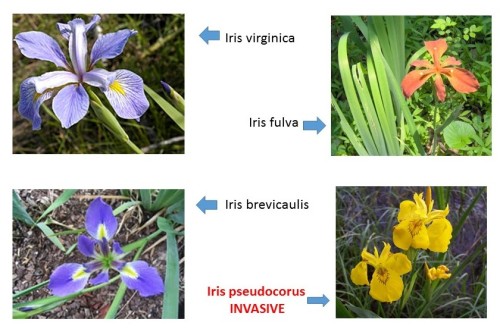
From the name of a greek goddess, to its use by Claude Monet within his famous garden and paintings, and further to its popular status as a diverse horticultural variety or cultivar, the Iris has widespread play within our culture and (more importantly) our natural world.
According to Correll and Correll (the authority on the aquatic and wetland plants of Southwestern US), there are “more than 200 species in the Northern Hemisphere.” We are lucky enough to have several native Iris species within our region, including Iris virginica, Iris brevicaulis, and Iris fulva. Both Iris virginica and Iris brevicaulis have the typical blue-purple and gold color pattern, whereas Iris fulva is distinctively coppery red in color and equally attractive. It is worth noting that our one unfortunate invasive Iris (Iris pseudacorus, which is native to Europe, western Asia and northwest Africa) has a large bright yellow flower, and reproduces rapidly via rhizomes and seeds, and we must be aware of this noxious invader. 
My first encounter with Irises came as a SCA/Americorps intern at San Bernard National Wildlife Refuge. Driving around Moccasin pond, I marveled at the pretty Iris blooms along the pond edge, intermingled with the native Canna (Canna glauca). The pond was teeming with life and flowers. Later, I took my godmother and my mom on a similar tour around the pond, and they also enjoyed the floral display (as well as the sunbathing gators strewn over the road edges).
As part of my restoration work at Sheldon Lake State Park and other sites around Galveston Bay, I have used only the two “blue” species–Iris virginica and Iris brevicaulis. Each species is specific to a region and habitat….where I. virginica can handle some salinity (fresh to brackish tidal conditions) and the coastal soils, I. brevicaulis finds its niche within the partial shady edges of forests. These showy natives bloom late spring to early summer, but their bright green to silvery green foliage can remain year-round. They are both considered obligate wetland plants making them ideal for wetland restoration in their appropriate place within the natural landscape.
When spring returns to our area early next year, be sure to seek out and admire these classic flowering wetland natives. 






